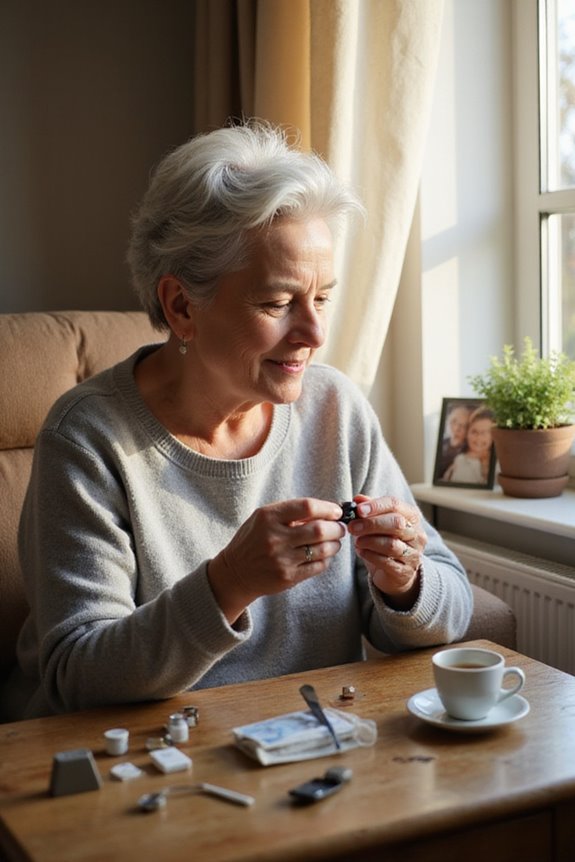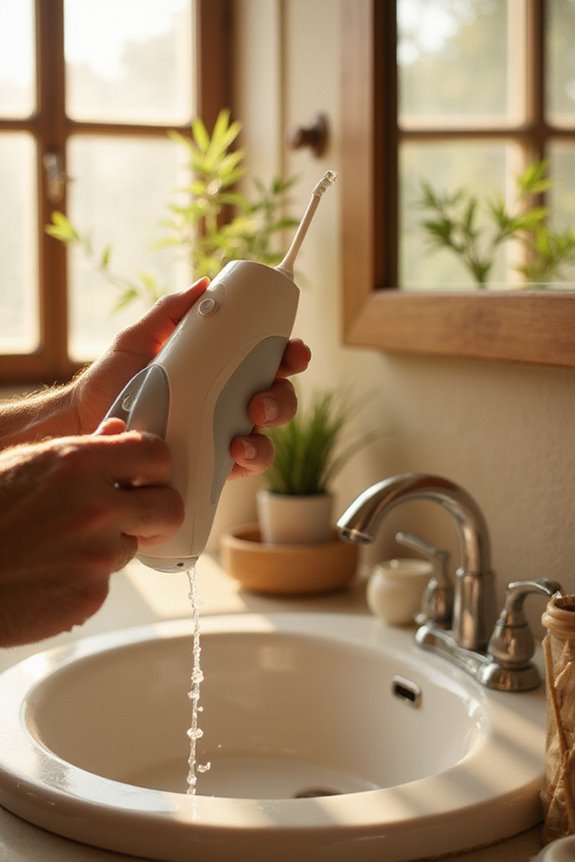Choosing the best at-home personal care devices involves several key considerations:
- Types of Devices: Understand available options, including washing aids, specialized grooming equipment, and dental care devices.
- Efficacy: Review peer-reviewed studies indicating clinical outcomes and user satisfaction.
- Safety Compliance: Guarantee adherence to IEC 60601-1 and UL 1431 standards for safety.
- User Experience: Focus on user-friendly interfaces and features that enhance daily routines.
Understanding these factors helps in making informed selections. More insights follow.
Key Takeaways
- Assess the specific needs of the user, considering health conditions and daily routines to ensure device compatibility and effectiveness.
- Ensure devices comply with safety standards like IEC 60601-1 and UL 1431 to prioritize user safety and reliability.
- Evaluate user-friendliness by checking for intuitive interfaces and features that support seamless navigation and accessibility.
- Research customer reviews and warranty policies to gauge device performance and the quality of customer support services.
- Analyze total costs, including purchase price, maintenance, and potential insurance coverage to align with your budget.
Understanding Different Types of At-Home Personal Care Devices
As individuals seek to enhance their personal care routines, understanding the various types of at-home personal care devices becomes essential. These devices cater to diverse user demographics, ensuring accessibility and ease of use.
Types of At-Home Personal Care Devices:
- Long-handled washing aids: Facilitate bathing and enhance safety.
- Specialized shaving equipment: Improves grip for effective grooming.
- Dental care devices: Stabilized toothbrushes promote better oral hygiene.
- Hair care aids: Long-handled brushes assist those with limited reach.
- Adaptive utensils: Enhance eating capabilities, supporting independence.
Bathtime Aids:
- Shower chairs and transfer benches: Provide stability and safety.
- Non-slip mats: Reduce hazards during bathing. Additionally, incorporating grab bars in bathrooms can significantly improve safety and prevent slips.
These devices exemplify device versatility, allowing users to maintain personal care routines with confidence and comfort, fostering a sense of belonging within their communities.
Evaluating Efficacy and Scientific Backing
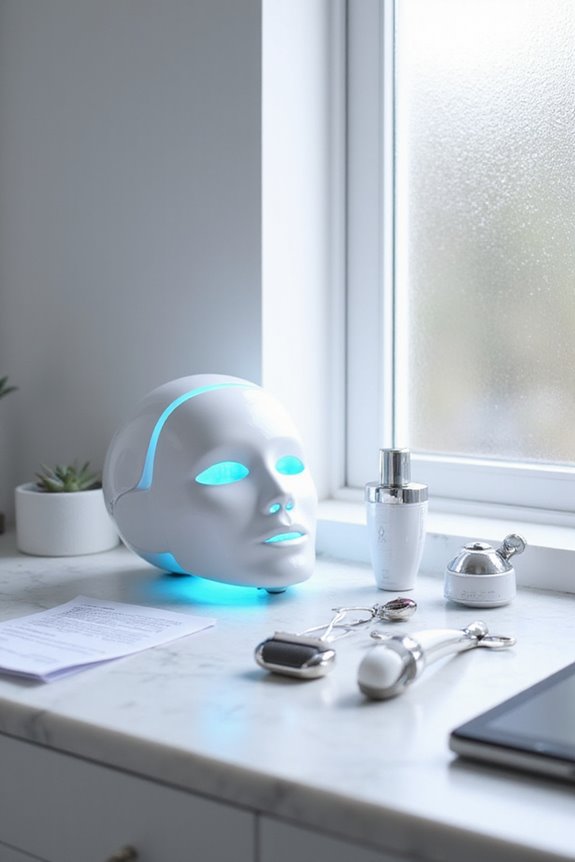
Evaluating the efficacy and scientific backing of at-home personal care devices is essential for understanding their impact on user health and well-being. Robust evidence from 163 peer-reviewed studies highlights measurable clinical outcomes, including:
- Continuous monitoring technologies that enhance patient self-management and reduce fall incidents.
- Improved medication adherence and symptom tracking reported widely among users.
- Positive feedback regarding quality of care and patient satisfaction.
Evidence sources indicate over two-thirds of studies report favorable results, supporting generalizability across diverse patient groups. Such findings underscore the potential of these devices to improve health-related quality of life and foster independent living. However, barriers such as user interface difficulty and privacy concerns can limit efficacy, necessitating careful consideration when selecting devices. Additionally, the accuracy of readings, particularly in glucose monitoring systems, plays a crucial role in effective health management.
Ensuring Safety and Regulatory Compliance
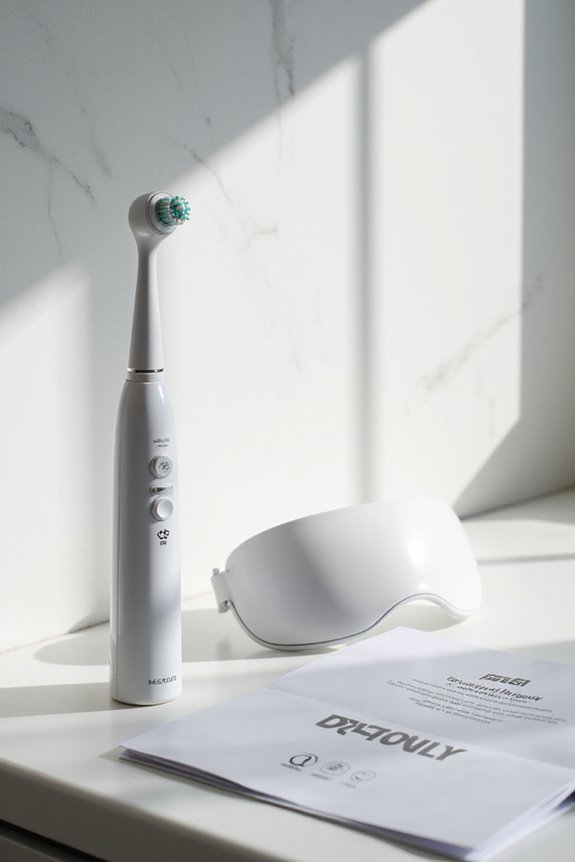
Compliance with these standards necessitates demonstrating product safety through design, user instructions, training, and maintenance protocols. Adherence to regulatory frameworks, such as IEC 60601-1 and UL 1431, is essential for ensuring safety standards are met in at-home personal care devices.
- IEC 60601-1-11 focuses on risks for untrained users, ensuring devices are safe in uncontrolled environments.
- Manufacturers must provide clear installation guidelines to mitigate risks.
- Regular training on device use and infection control is vital for caregivers.
Enhancing User Experience and Convenience
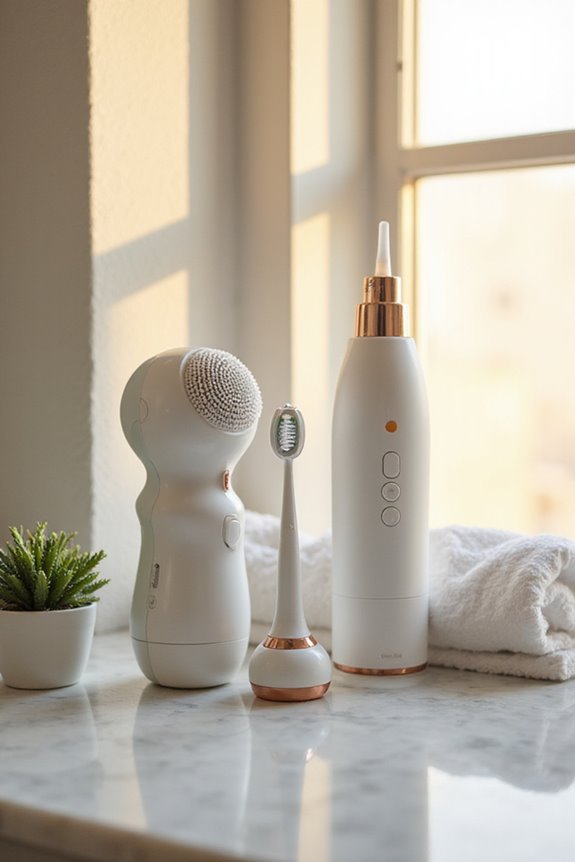
Enhancing user experience and convenience in at-home personal care devices is crucial for maximizing their effectiveness and promoting user adherence. User friendly interfaces, characterized by intuitive designs, enable easy navigation and reduce confusion among users. Key features, such as medication reminders and appointment schedules, should be prominently displayed for quick access.
Seamless synchronization across devices guarantees that essential information, including alerts and reminders, is consistently accessible. This coordination not only enhances reliability but also supports caregivers in efficiently managing care.
Additionally, adaptable layouts and customizable home screens cater to individual user habits, promoting a sense of belonging and personal connection. By integrating features that support daily routines, these devices become critical tools for maintaining health and well-being. Utilizing adaptive utensils can further enhance mealtime independence for users with limited dexterity.
Assessing Cost and Value Considerations
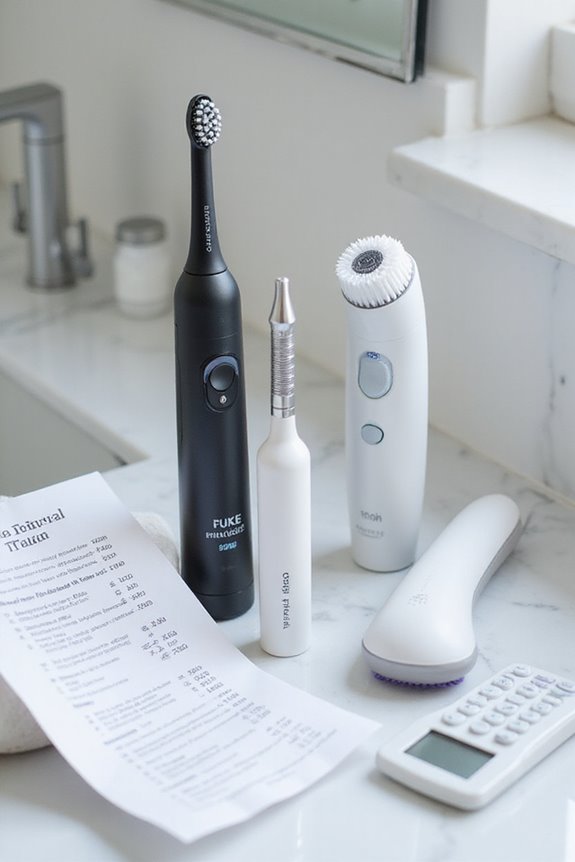
How do individuals and families navigate the complex landscape of costs associated with at-home personal care devices and services? Understanding cost transparency is vital, as pricing models vary considerably across locations and service types.
- Hourly Rates: Typically range from $25 to $40, averaging $30.
- Monthly Costs: Part-time care averages $819, while full-time live-in care can exceed $10,645.
- 24/7 Care Expense: Median costs reach $21,823 monthly.
Value comparison is essential when evaluating options. Higher-priced agencies often offer better quality assurance through trained staff and supervision.
– Insurance Coverage: Options like Medicare or private insurance can offset costs, while out-of-pocket payments require careful budgeting.
Ultimately, families must weigh both cost and value to make informed decisions on personal care devices.
Identifying Your Specific Skin or Health Needs
Identifying specific skin or health needs is essential for selecting the most effective at-home personal care devices. Understanding individual skin conditions allows for tailored solutions that align with personal goals.
- Acne and Breakouts: Consider devices like LED masks for blue light therapy.
- Aging and Fine Lines: Red light therapy can enhance skin texture.
- Hair Removal: IPL devices offer effective, long-term solutions.
- Puffiness: Ice rollers can alleviate morning swelling.
- Skin Elasticity: Consider tools like the TheraFace Wand for improved elasticity.
Evaluating skin types is equally important. Sensitive skin may require gentler options, while oily skin can benefit from steamers. An informed selection based on needs maximizes the efficacy of at-home treatments, ensuring a more satisfying personal care experience.
Exploring Broader Health and Wellness Device Trends
The increasing prevalence of chronic lifestyle diseases is prompting consumer demand for continuous health monitoring. This shift is reflected in the anticipated global market for health and wellness devices, projected to reach USD 909.68 billion by 2030, growing at a CAGR of 9.38% from 2024-2030.
Key trends include:
- Integration of trending technologies: AI and machine learning are enhancing device capabilities, enabling predictive analytics for early intervention.
- Consumer preferences: There is growing interest in personalized health insights and holistic wellness solutions.
- Emerging device categories: Home wellness devices now encompass stress detection, metabolic analysis, and chronic disease management, facilitating user-friendly health management. Additionally, the rise of wireless blood pressure monitors reflects the demand for accurate and convenient health tracking solutions.
Such advancements showcase the dynamic landscape of health and wellness devices, aligning with evolving consumer expectations.
Making Informed Decisions for At-Home Care
Making informed decisions for at-home care requires a systematic assessment of individual health needs and device capabilities.
Understanding Needs
- Assess specific health conditions, such as mobility support or chronic disease management.
- Consider the user’s technological proficiency to avoid complicated interfaces.
Evaluating Features
- Seek devices with remote monitoring for real-time health tracking.
- Ascertain compatibility with smartphones and wearable technology.
Compliance and Safety
- Confirm compliance with healthcare regulations and privacy standards.
- Investigate warranty and customer support policies.
Cost and Coverage
- Analyze total costs, including purchase price and maintenance.
- Review insurance coverage and reimbursement options.
Informed device selection enhances personal care and guarantees effective health management, especially when considering safety standards compliance to ensure reliability during emergencies.
Frequently Asked Questions
How Often Should I Use At-Home Personal Care Devices?
A hypothetical patient, Jane, follows frequency guidelines by using her electric toothbrush twice daily. Usage recommendations suggest adherence to these schedules, ensuring ideal care and maintaining health. Consistency in device use promotes better health outcomes overall.
Can I Use Multiple Devices Simultaneously for Better Results?
Simultaneous usage of multiple devices can enhance results, but device compatibility is essential. Users should be cautious, as improper combinations may lead to reduced effectiveness or safety risks, emphasizing the importance of understanding each device’s requirements.
What Skin Types Are Best Suited for These Devices?
Different skin types benefit uniquely from at-home devices: dry skin needs hydration, oily skin thrives with cleansing tools, sensitive skin requires gentler options, combination skin suits versatile devices, while aging and acne-prone skin seek targeted solutions.
Are There Any Side Effects to Using At-Home Personal Care Devices?
Concerns about side effects from at-home personal care devices include device sensitivity and potential injuries. Users should practice precautions, such as proper cleaning and following guidelines, to enhance safety and avoid complications in their care routines.
How Do I Maintain and Clean My Personal Care Devices?
Many believe that maintaining personal care devices is tedious; however, utilizing proper cleaning techniques and ensuring appropriate device storage can enhance longevity and effectiveness, fostering a sense of belonging to a community that values self-care.



